sentinel数据持久化mysql_12.05.sentinel规则持久化
## sentinel规则持久化
生产环境上,一般都是通过动态规则持久化的方式来动态的管理限流规则,也就是说,很多时候流控规则都会存储在文件,数据库或者配置中心当中,Sentinel的DataSource接口给我们提供了对接任意配置源的能力。所谓的动态规则就是通过控制台配置规则后持久化到各个数据源中。
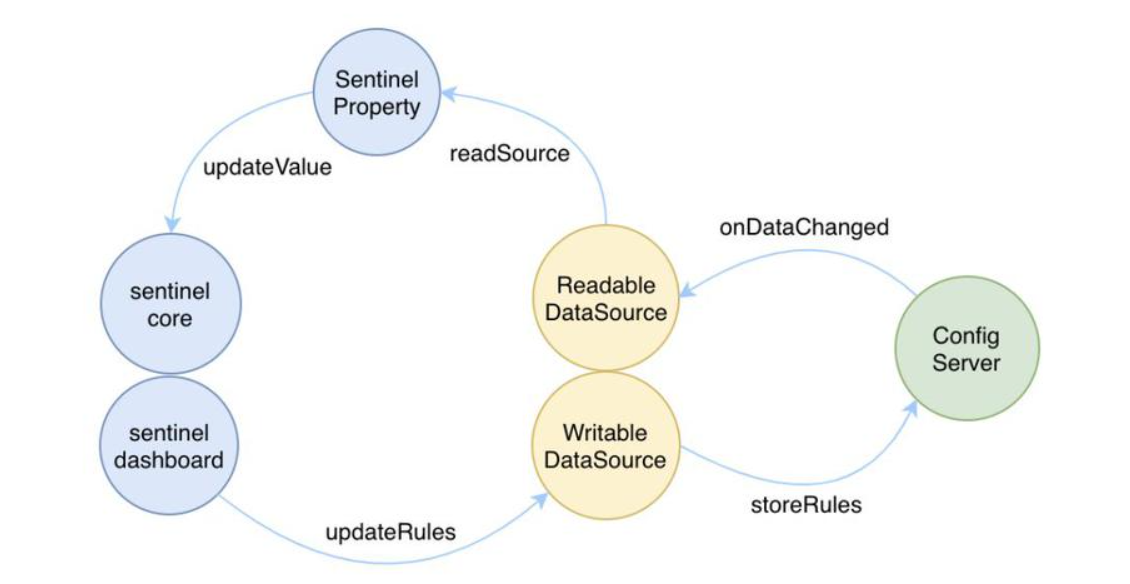
## sentinel的两个DataSource接口
* ReadableDataSource:读数据源负责监听持久化的数据源的变更,在接收到变更事件时将最新的数据更新
* WritableDataSource:写数据源负责将变更后的规则写入到持久化的数据源中
## sentinel-extension模块分析
在 1.7.1 版本,sentinel-extension 模块下的子模块除 sentinel-parameter-flow-control、sentinel-annotation-aspectj 之外,其余子模块都是实现动态数据源的模块。
* sentinel-datasource-extension:定义动态数据源接口、提供抽象类
* sentinel-datasource-redis:基于 Redis 实现的动态数据源
* sentinel-datasource-zookeeper: 基于 ZooKeeper 实现的动态数据源
* 其它省略
sentinel-datasource-extension 模块是 Sentinel 实现动态数据源的核心。
### SentinelProperty
SentinelProperty 是 Sentinel 提供的一个接口,可注册到 Sentinel 提供的各种规则的 Manager,例如 FlowRuleManager,并且可以给 SentinelProperty 添加监听器,在配置改变时,你可以调用 SentinelProperty#updateValue 方法,由它负责调用监听器去更新规则,而不需要调用 FlowRuleManager#loadRules 方法。同时,你也可以注册额外的监听器,在配置改变时做些别的事情。
SentinelProperty 并非 sentinel-datasource-extension 模块中定义的接口,而是 sentinel-core 定义的接口,其源码如下:
~~~
public interface SentinelProperty {
void addListener(PropertyListener listener);
void removeListener(PropertyListener listener);
boolean updateValue(T newValue);
}
~~~
* addListener:添加监听器
* removeListener:移除监听器
* updateValue:通知所有监听器配置更新,参数 newValue 为新的配置
默认使用的实现类是 DynamicSentinelProperty,其实现源码如下:
~~~
public class DynamicSentinelProperty implements SentinelProperty {
// 存储注册的监听器
protected Set> listeners = Collections.synchronizedSet(new HashSet>());
@Override
public void addListener(PropertyListener listener) {
listeners.add(listener);
listener.configLoad(value);
}
@Override
public void removeListener(PropertyListener listener) {
listeners.remove(listener);
}
@Override
public boolean updateValue(T newValue) {
for (PropertyListener listener : listeners) {
listener.configUpdate(newValue);
}
return true;
}
}
~~~
DynamicSentinelProperty 使用 Set 存储已注册的监听器,updateValue 负责通知所有监听器,调用监听器的 configUpdate 方法。
~~~
private static SentinelProperty> currentProperty = new DynamicSentinelProperty>();/** * Load {@link FlowRule}s, former rules will be replaced. * * @param rules new rules to load. */public static void loadRules(List rules) { currentProperty.updateValue(rules);}
~~~
在前面分析 FlowRuleManager 时,我们只关注了其 loadRules 方法,除了使用 loadRules 方法加载规则配置之外,FlowRuleManager 还提供 registerProperty API,用于注册 SentinelProperty。
使用 SentinelProperty 实现加载 FlowRule 的步骤如下:
1. 给 FlowRuleManager 注册一个 SentinelProperty,替换 FlowRuleManager 默认创建的 SentinelProperty(因为默认的 SentinelProperty 外部拿不到);
2. 这一步由 FlowRuleManager 完成,FlowRuleManager 会给 SentinelProperty 注册 FlowPropertyListener 监听器,该监听器负责更新 FlowRuleManager.flowRules 缓存的限流规则;
3. 在应用启动或者规则配置改变时,只需要调用 SentinelProperty#updateValue 方法,由 updateValue 通知 FlowPropertyListener 监听器去更新规则。
FlowRuleManager 支持使用 SentinelProperty 加载或更新限流规则的实现源码如下:
~~~
public class FlowRuleManager {
// 缓存限流规则
private static final Map> flowRules = new ConcurrentHashMap>();
// PropertyListener 监听器
private static final FlowPropertyListener LISTENER = new FlowPropertyListener();
// SentinelProperty
private static SentinelProperty> currentProperty
// 提供默认的 SentinelProperty
= new DynamicSentinelProperty>();
static {
// 给默认的 SentinelProperty 注册监听器(FlowPropertyListener)
currentProperty.addListener(LISTENER);
}
// 注册 SentinelProperty
public static void register2Property(SentinelProperty> property) {
synchronized (LISTENER) {
currentProperty.removeListener(LISTENER);
// 注册监听器
property.addListener(LISTENER);
currentProperty = property;
}
}
}
~~~
实现更新限流规则缓存的 FlowPropertyListener 是 FlowRuleManager 的一个内部类,其源码如下:
~~~
private static final class FlowPropertyListener implements PropertyListener> {
@Override
public void configUpdate(List value) {
Map> rules = FlowRuleUtil.buildFlowRuleMap(value);
if (rules != null) {
// 先清空缓存再写入
flowRules.clear();
flowRules.putAll(rules);
}
}
@Override
public void configLoad(List conf) {
Map> rules = FlowRuleUtil.buildFlowRuleMap(conf);
if (rules != null) {
flowRules.clear();
flowRules.putAll(rules);
}
}
}
~~~
PropertyListener 接口定义的两个方法:
* configUpdate:在规则更新时被调用,被调用的时机就是在 SentinelProperty#updateValue 方法被调用时。
* configLoad:在规则首次加载时被调用,是否会被调用由 SentinelProperty 决定。DynamicSentinelProperty 就没有调用这个方法。
所以,现在我们有两种方法更新限流规则:
* 调用 FlowRuleManager#loadRules 方法
* 注册 SentinelProperty,调用 SentinelProperty#updateValue 方法
### ReadableDataSource
Sentinel 将读和写数据源抽离成两个接口,一开始只有读接口,写接口是后面才加的功能,目前来看,写接口只在热点参数限流模块中使用到。事实上,使用读接口就已经满足我们的需求。ReadableDataSource 接口的定义如下:
~~~
public interface ReadableDataSource {
T loadConfig() throws Exception;
S readSource() throws Exception;
SentinelProperty getProperty();
void close() throws Exception;
}
~~~
ReadableDataSource 是一个泛型接口,参数化类型 S 代表用于装载从数据源读取的配置的类型,参数化类型 T 代表对应 Sentinel 中的规则类型。例如,我们可以定义一个 FlowRuleProps 类,用于装载从 yml 配置文件中读取的限流规则配置,然后再将 FlowRuleProps 转为 FlowRule,所以 S 可以替换为 FlowRuleProps,T 可以替换为`List`。
ReadableDataSource 接口定义的方法解释说明如下:
* loadConfig:加载配置。
* readSource:从数据源读取配置,数据源可以是 yaml 配置文件,可以是 MySQL、Redis 等,由实现类决定从哪种数据源读取配置。
* getProperty:获取 SentinelProperty。
* close:用于关闭数据源,例如使用文件存储配置时,可在此方法实现关闭文件输入流等。
如果动态数据源提供 SentinelProperty,则可以调用 getProperty 方法获取动态数据源的 SentinelProperty,将 SentinelProperty 注册给规则管理器(XxxManager),动态数据源在读取到配置时就可以调用自身 SentinelProperty 的 updateValue 方法通知规则管理器(XxxManager)更新规则。
AbstractDataSource 是一个抽象类,该类实现 ReadableDataSource 接口,用于简化具体动态数据源的实现,子类只需要继承 AbstractDataSource 并实现 readSource 方法即可。AbstractDataSource 源码如下:
~~~
public abstract class AbstractDataSource implements ReadableDataSource {
protected final Converter parser;
protected final SentinelProperty property;
public AbstractDataSource(Converter parser) {
if (parser == null) {
throw new IllegalArgumentException("parser can't be null");
}
this.parser = parser;
this.property = new DynamicSentinelProperty();
}
@Override
public T loadConfig() throws Exception {
return loadConfig(readSource());
}
public T loadConfig(S conf) throws Exception {
T value = parser.convert(conf);
return value;
}
@Override
public SentinelProperty getProperty() {
return property;
}
}
~~~
从源码可以看出:
* AbstractDataSource 要求所有子类都必须提供一个数据转换器(Converter),Converter 用于将 S 类型的对象转为 T 类型对象,例如将 FlowRuleProps 对象转为 FlowRule 集合。
* AbstractDataSource 在构造方法中创建 DynamicSentinelProperty,因此子类无需创建 SentinelProperty。
* AbstractDataSource 实现 loadConfig 方法,首先调用子类实现的 readSource 方法从数据源读取配置,返回的对象类型为 S,再调用 Converter#convert 方法,将对象类型由 S 转为 T。
Converter 接口的定义如下:
~~~
public interface Converter {
T convert(S source);
}
~~~
* convert:将类型为 S 的参数 source 转为类型为 T 的对象。
## sentinel可以支持4种持久化策略
* nacos分布式配置中心
* 阿波罗配置中心
* zookeeper
* 本地文件

## 规则流程
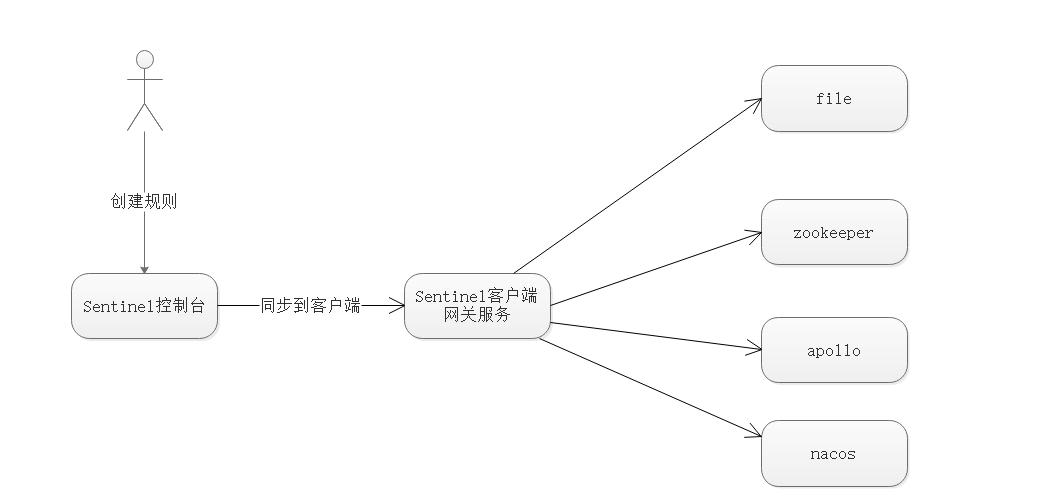
## 改造内容
### 推模式
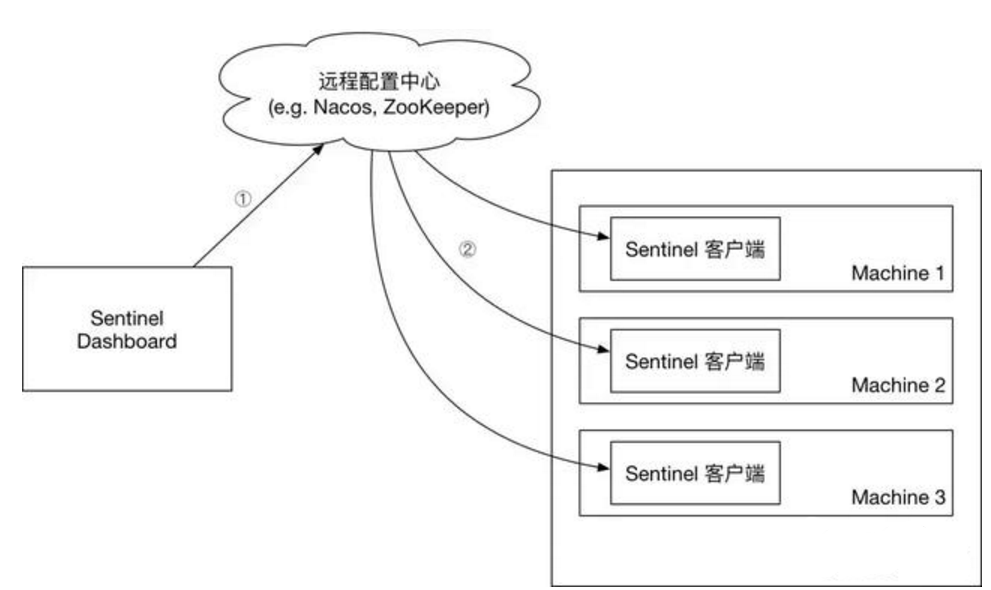
* 增加nacos地址
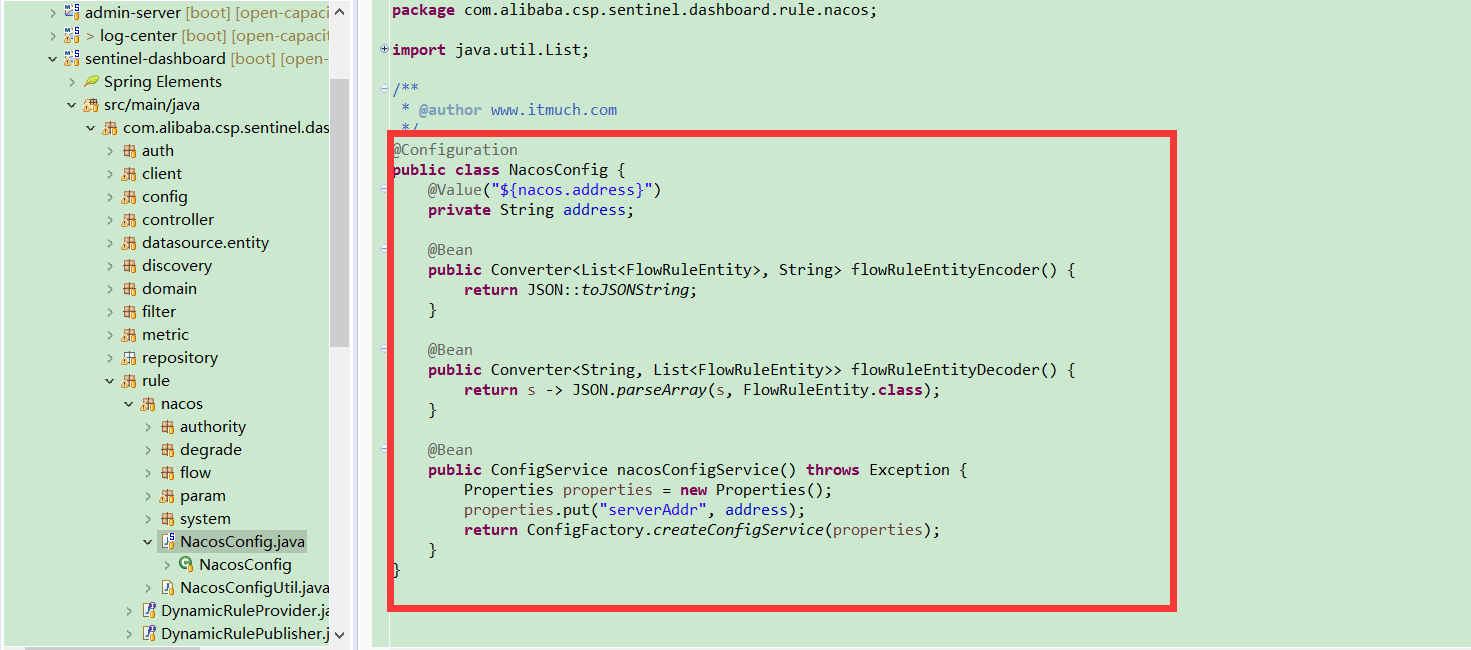
* 增加配置
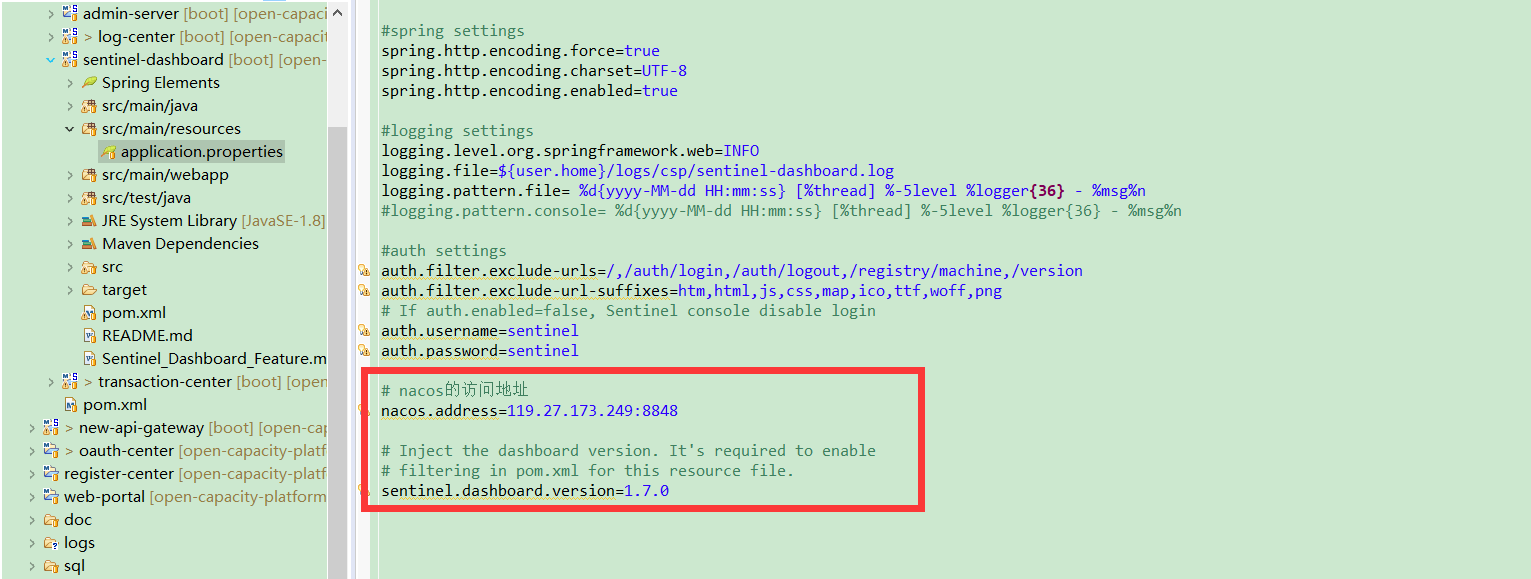
* 增加nacos
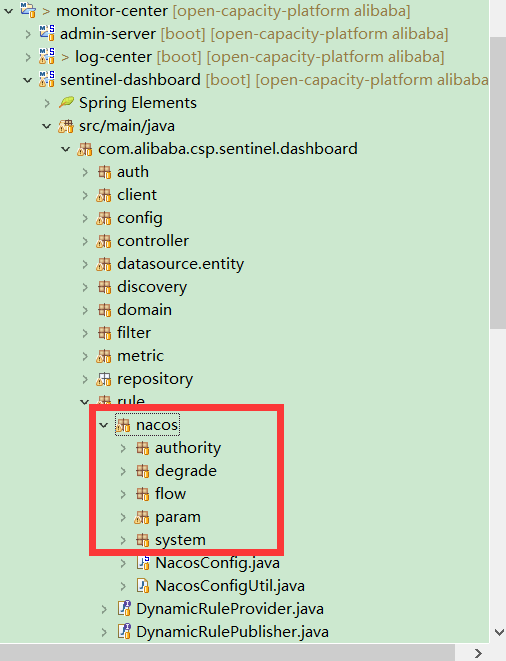
* 修改 com.alibaba.csp.sentinel.dashboard.controller.v2.FlowControllerV2 ,找到
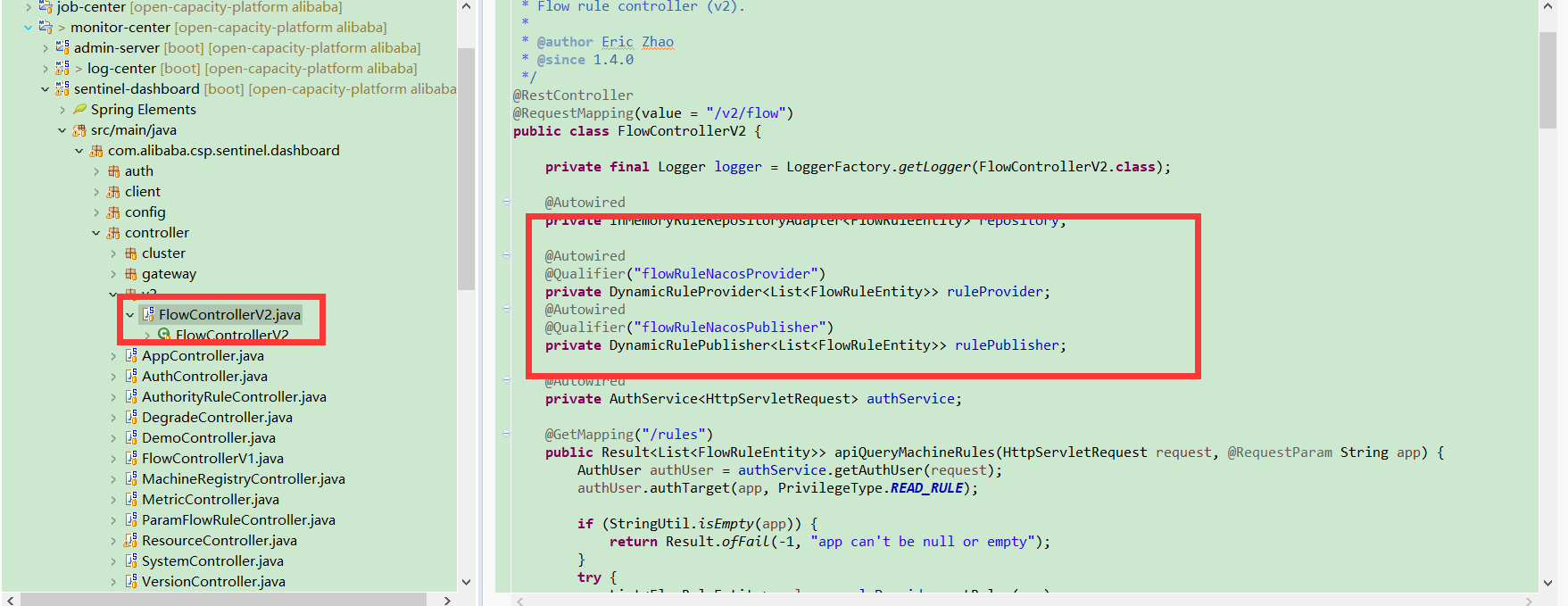
* 注释选中代码
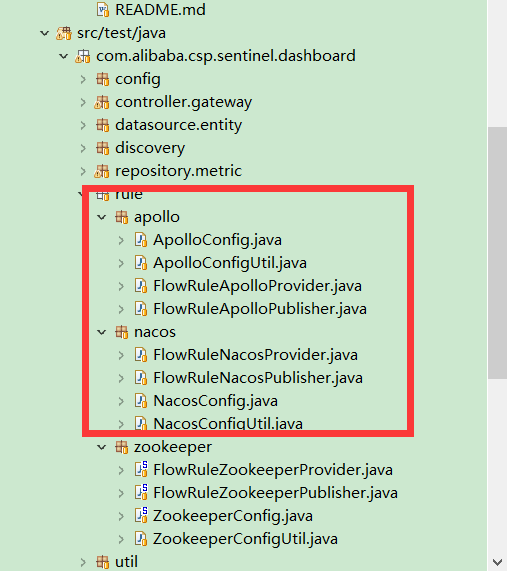
* 修改流控规则代码
